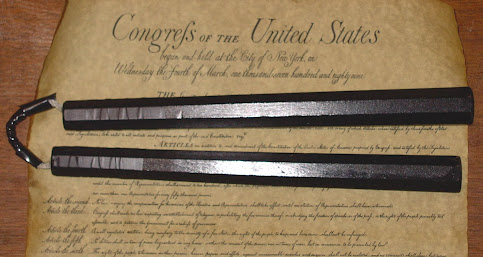The events that led to a constitutional challenge
In August 2000, police came to my home after a telephone company employee claimed that I had pointed a rifle at him from within my home. (There was a telescope involved, but no rifle.) When police arrived, they had neither a search warrant nor an arrest warrant, so I refused them entry. As a result, the situation escalated, and a team of police surrounded my home, cut off my phone lines, and persisted for twelve hours in demanding that I exit my home and surrender. They never obtained a warrant during that entire time. Nevertheless, after twelve hours, myself and my family worn out, I stopped asserting my constitutional right under Payton v. New York, 445 U.S. 573 (1980), of which I was well aware at the time, and came outside peacefully. In my absence, the police searched my home, finding my nunchaku under a couch.
I was never charged with resisting arrest, nor indeed with any “intent” crime (other than the alleged “menacing” of the phone worker, which was ultimately dismissed separate and apart from any plea bargaining), but the nunchaku found in my home gave rise to a misdemeanor possession charge against me that was not resolved until January 2003, when I pled guilty to a violation (not a crime), upon which all charges were dismissed.
Less than a month later, in February 2003, I commenced the federal constitutional challenge that was originally titled Maloney v. Spitzer, was later renamed Maloney v. Cuomo, and is now known as Maloney v. Rice. In the case, I sought (and continue to seek) a declaration that the criminalization of the mere possession of nunchaku in one’s own home is unconstitutional.
As the District Court noted in its reported opinion, Maloney v. Cuomo, 470 F. Supp. 2d 205 (E.D.N.Y. 2007), “The criminal charge[] for possession of nunchaku was based solely on in-home possession, and not supported by any allegations that the plaintiff had used the nunchaku in the commission of a crime; that he carried the nunchaku in public; or engaged in any other prohibited conduct in connection with said nunchaku. Thus, the only criminal activity alleged against the plaintiff was his possession of the nunchaku in his home.” In that same opinion, the District Court ultimately decided that neither the Second Amendment nor any other federally guaranteed right prevented New York from defining the mere possession of nunchaku in one’s own home as a crime punishable by up to a year in prison. The Second Circuit affirmed that decision in January 2009. Supreme Court review has been sought in a petition for certiorari that counsel filed on my behalf on June 26, 2009. As I write this post on July 4, 2009, we remain hopeful that the United States Supreme Court will review the case. [UPDATES: In June 2010, the Supreme Court granted certiorari, vacated the judgment of the Second Circuit, and remanded for further consideration in light of McDonald v. Chicago. For the next eight years, the case was before the District Court as Maloney v. Singas. A trial was held in January 2017, and a decision striking down the nunchaku ban was handed down on December 14, 2018. See “The Eighth Post,” above, for details and an important cautionary note. Click here or on the word “decision” above (two different links) for a pdf copy of the decision.]









